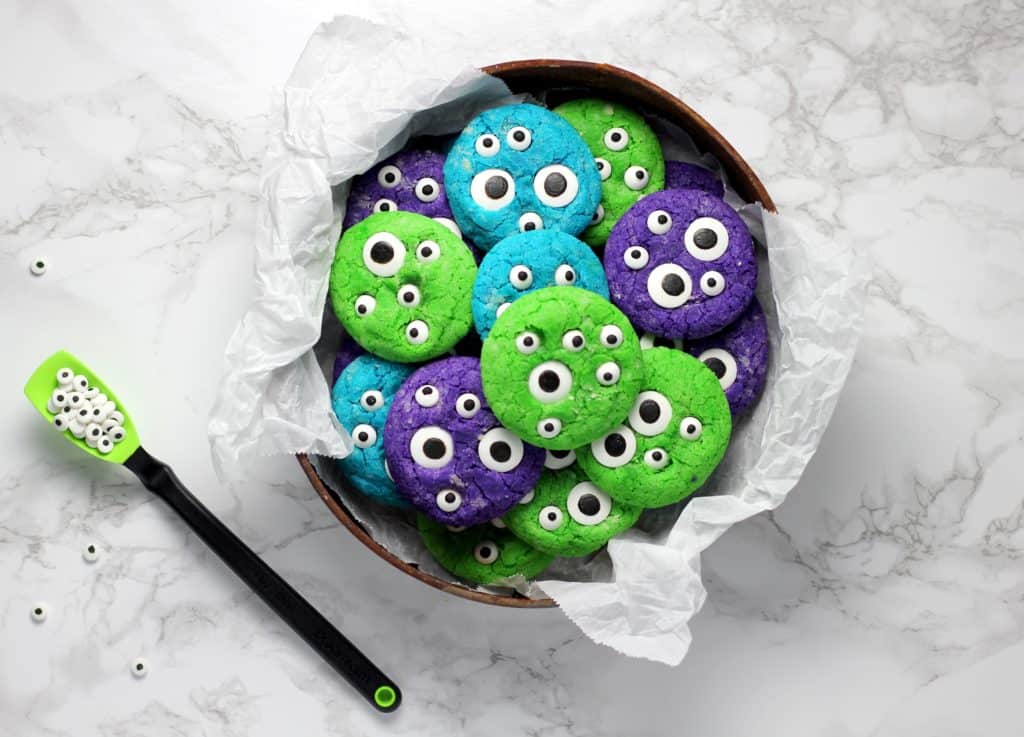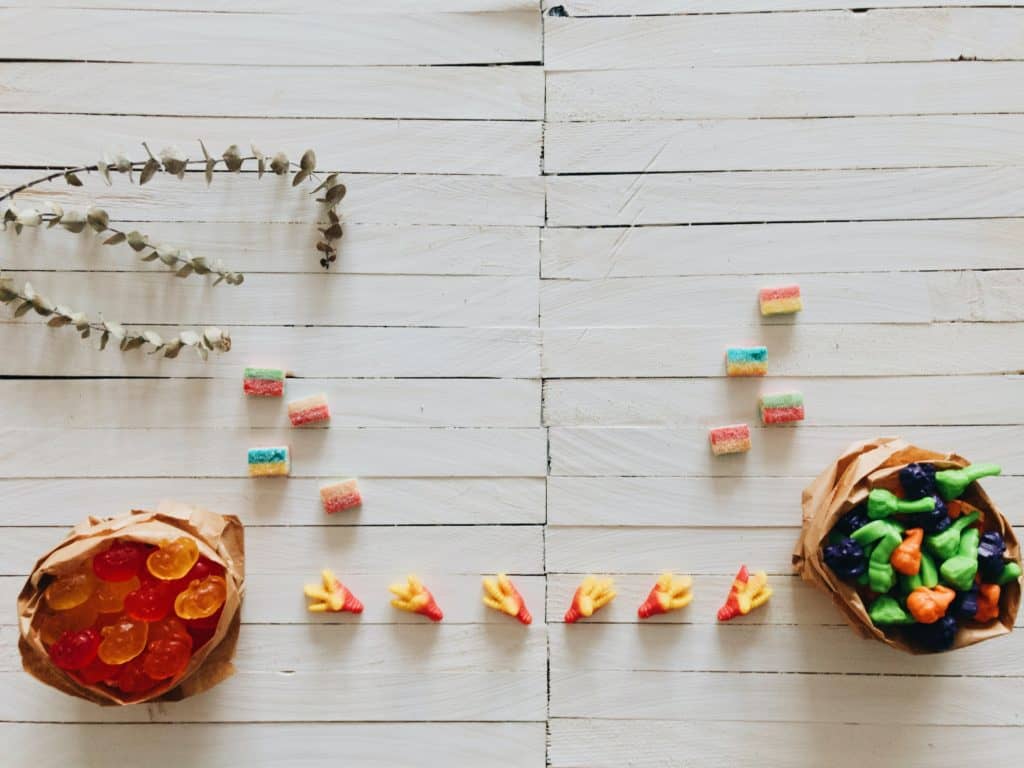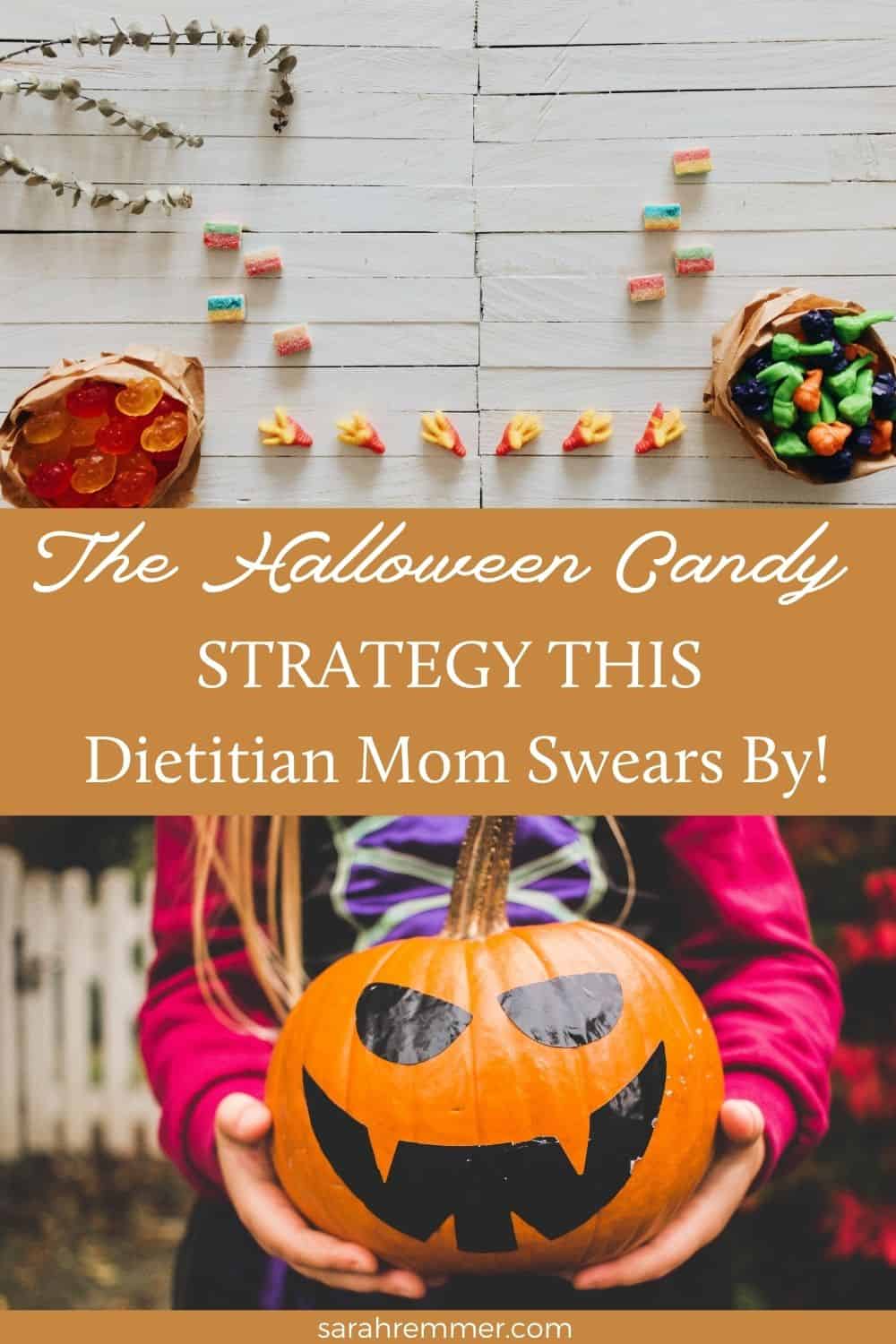Stressed about Halloween candy? As much as you feel the need to play “treat police” this Halloween, try not to. It’s no fun for you as the parent, and it takes the joy out of Halloween for your kids. Here’s my 7-step strategy that not only takes the stress away from parents, but creates a positive experience for kids.

Did you know that Halloween can be a great teaching opportunity for kids, to learn to be mindful and calm around treats and sweets? You bet! As parents, we have the power to use this holiday to strengthen our child’s relationship with food and help them to be calm and mindful around sweets.
On the other hand, it can also do the opposite and create disordered eating behaviours later on. Sneaking treats, hoarding them, overeating on them, etc. As intuitive as it might be for us to micromanage, restrict, police or withhold these sweet treats (especially if this is what happened to you as a child), it can backfire in a major way.
Concerns you may have about Halloween candy:
What if my child goes crazy on Halloween candy and eats way too much?
Good question! They might! But this is ok. One or two days of gorging on candy is not going to make a lick of difference when it comes to their nutritional status, dental health or behaviour. I promise! It might result in a tummy ache or feeling crappy, which is not a bad thing – it will teach them to be more mindful next time (in fact, this can be the most powerful natural consequence!).
What if they become addicted to sugar and that’s all they ask for?
It won’t. Allowing your child to go to town on their candy and have as much as they want on Halloween night will be a thrill for them, but they’ll also learn that the candy wasn’t as amazing as they thought it would be. Having too much actually doesn’t feel great. They may surprise you and have a few candies and then save the rest or just lose interest altogether. The more relaxed and calm we are about it, the more they will be too.

What if they gorge on it and feel sick after?
Perfect! This is a great natural consequence! Don’t shame them or make them feel bad about it, but instead be inquisitive and compassionately curious. Ask them why they think they feel that way. Ask them what they think the best way to avoid that next time might be. Be cautious about how you approach these questions though…you don’t want to come off as “I told you so”.
What if they don’t eat their nutritious foods because they’re too full from candy?
Your’e still in charge of what, when and where food happens. You’ll still serve balanced, nutritious meals and snacks on Halloween day so that they have the opportunity to meet their nutritional requirements, just like every other day. Let your kids have as much candy as they want after trick or treating, and then decide together how many candies your kids will have in the days that follow. Maybe it’s 2-3 small candies? One with their morning snack, one with lunch and maybe one with dinner? This way, they aren’t displacing other nutritious foods in their diet.
What if all of that sugar affects their behaviour?
It won’t. There’s actually no science to support the idea that sugar makes kids hyperactive.
Consider where your fears are rooted, and if they are warranted
Many of our fears are based on our own experiences as kids. Many of us were micromanaged and told that if we eat too much junk food or candy, we’d ruin our teeth, gain weight, be unhealthy… what else?! And many of these messages created disordered thoughts and behaviours about food, our bodies and treats, and might have even led to disordered eating or chronic dieting. These are generational patterns, messages and beliefs that we have the power to shift with our own kids. We know better now – we can actually stop this cycle of disordered thoughts around treats and desserts.
Out ultimate goal for our kids is to have them be relaxed, calm and neutral about treat foods. We want them to be exposed to them (because they will anyways!), and be able to manage them and be mindful with them. Here’s how to do that:

#1 Call them what they are:
Calling candy, chocolate, chips etc. “junk food”, “fun foods”, “sometimes foods”, “bad foods”, etc. only create more allure, excitement and anticipation for them. Labeling foods can also create a situation where kids are labeling themselves… if they’re eating “bad foods”, does that make them “bad”? Kids think in concrete terms – they will start to attach moral value to foods and, in turn themselves, if it’s done regularly.
All foods offer value – candy on Halloween is FUN, yummy and creates positive memories. It also contains carbohydrates which can help to fuel your body and brain. All valuable! And we need other foods (fruits, veggies, protein-rich foods, whole grains etc.) to provide other value (benefits for our body). The point is, we want to neutralize all foods so that certain foods aren’t put on a pedestal or more sought after (candy), and other foods are avoided (veggies). So, call them what they are: gummy bears, liquorice, chocolate bar, etc. They’re just food!
#2 Fuel up:
Serve a nourishing, filling supper before heading out trick-or-treating, just like you would any other night. Your kids may not fill up as much as they usually do because of the anticipation and excitement of Halloween. That’s ok and normal. Also, a filling meal might not mean that they won’t go crazy on candy (and again, this is ok), but at least it gives them a good chance to fill up on nutrient-dense foods beforehand. It might help them to be a little more mindful with their candy stash too, if their tummies are satisfied.
Check out my Top 10 Easy Weeknight Dinner recipes for some inspiration for a healthy pre trick-or-treat dinner!
#3 Pour it out and sort it out:
When your kids return, get them to sort through their candy and separate the “can’t-live-withouts”, and put the “just oks”. This is also a chance for you to inspect for safety (open packages etc.). This is one case in which you may want to encourage your child to be a bit of a picky eater. The point of this is to teach your kids to enjoy foods that they actually like, and to be choosy in what they indulge in. You don’t want your kids to eat the candy just because it’s … candy. Don’t micromanage or hover over them when they’re doing this – and honestly, you don’t even have to facilitate this because they’ll probably do it on their own! Remember going through your candy and trading with your siblings? This is not only fun, but also an exercise in being discerning with which candy they keep!

#4 Encourage bravery:
Now I know that I just said to teach your kids to be picky when it comes to treats, but you could also encourage them to try something new. Do something that your kids don’t expect and encourage them to try a new Halloween candy or chocolate treat that they’ve never had before, or that they’re unsure of. For example, if they always go for gummy-type candies, encourage them to try a mini chocolate bar with nuts in it. This will not only put treats on a more level playing field with other foods (which will decrease the desirability of them), but will also encourage them to be more adventurous with all foods (including healthier ones at mealtimes).
#5 Let them enjoy:
Without micro-managing your child’s consumption, let them eat as much as they want on Halloween night (and even for a couple of days following). Your child might surprise you by having a few and then deciding to save the rest (like my son usually does), or gorging on them and eating until they feel sick (like my daughter might).
Either way, it ultimately teaches your child how to self-regulate their intake of treats down the road. It also removes the “forbidden-fruit” factor. If kids have free rein to enjoy their candy (or treat foods in general) sometimes, and they know that they can have access to it regularly, it takes the urgency to “get it in while you can!” away. It also decreases the chances of your kids sneaking candy or over-indulging when you’re not there. And I promise you–one or two days of gorging on treats will not affect their long-term nutritional or health status.
#6 Don’t micro-manage:
If you take charge of the candy stash and police when and how much candy can be consumed, you’re sending the message that your kids cannot be trusted with it. In other words, this doesn’t teach them how to moderate their intake of treats.
In the first two years of life, kids don’t need (and shouldn’t really eat) candy or high sugar treats at all (with the exception of birthday cake of course). They’re nutrient needs are too big, and their tummies too little. From ages two to four years old, kids aren’t old enough to manage their candy stash on their own, so it’s best if you help them by coming up with a daily amount of candy that seems fair (maybe it’s one, two, or four depending on age) and allowing your child to decide when they are going to have it (it could be for dessert after lunch, as part of a snack in the afternoon, or even WITH a meal). You can be flexible of course, but the point is, you manage the stash. For kids ages four and up, they are likely ready to manage and store their own stash with the expectation that they will adhere to the boundaries that were negotiated and eat their candy in a designated area (usually the kitchen table where there are few distractions).
Giving kids the opportunity to manage their candy stash will take some of the power away from the candy and give them the confidence to manage their treats in a healthy way. Regardless off age, I encourage parents to decide when designated eating times are (grazing all day on snacks–or candy for that matter–is a recipe for mindless eating and mealtime battles (and potential health/weight issues down the road).
#7 Let them learn:
Kids learn by experience, and however upsetting it is for us parents to see our kids gorge on treats (and even get sick), ultimately, this will teach our kids to moderate their intake of them.
Instead of getting angry and punishing kids for eating too many candies, approach the situation calmly and get your child to talk about it. Ask her why she thinks she feels sick and what she might do next time to avoid the same feeling again. Explain how the fun is taken out when too many Halloween candies or too much chocolate is consumed. Instead of feeling embarrassed and ashamed, your child will learn from her mistake and think twice before doing it again. Honestly, you probably don’t have to even say a word – your child will learn this on their own!
Don’t dread Halloween because of the candy overload. Think of it as a great opportunity to teach your kids about balance, mindfulness, but most importantly, FUN!
Commonly Asked Questions About Halloween Candy
It’s important to remember that treats and desserts play an important part in your child’s life when it comes to a positive relationship with food. You can help your kids eat treats mindfully and in moderation.
Ultimately, it is up to your child to listen to their body to determine how much is enough. Kids learn by making mistakes, and however upsetting it is for us parents to see our kids gorge on treats (and even get sick), ultimately, this will teach our kids to moderate their intake of them. Here are 5 common feeding mistakes parents make.
It won’t. There’s actually no evidence to support the idea that sugar makes kids hyperactive. Instead, it’s likely the time and place that is causing excitement. The very idea of Halloween is exciting to kids, which creates the illusion of hyperactivity.




![[AD] It’s Day 6 of my 15-Minute Supper Series and today we’re putting a delicious twist on a classic BLT to make it nourishing and meal-worthy 🤤
Make sure to comment “Spud” and I’ll send you my top dietitian tips for feeding your family on busy weeknights along with a huge list of meal ideas!
This pasta salad takes no time at all to throw together and has everything you need for a nourishing meal. I always make extra bacon for things like this, but if you don’t have any cooked bacon I find cooking it in the airfryer or stovetop the quickest 🥓
I find that this salad lasts 2-3 days in the fridge without getting too soggy. You can also add in fresh lettuce to crisp it up or add the dressing when you eat it.
I ordered all of my groceries from @spuddelivers, which always saves me time and effort and gives me peace of mind knowing that I’m using high-quality, local and sustainable ingredients. I love that they come straight to my door the day after ordering 🙌🏻
Let’s make it!
Ingredients:
* 10 slices bacon cooked and diced
* 12 ounces pasta cooked and cooled
* 1 cup homemade Ranch dressing
* 1 ½ cup baby tomatoes diced
* ½ avocado diced
* feta
* ⅓ cup red onion diced
* 1 cup romaine lettuce
* fresh parsley for garnish optional
Homemade ranch dressing:
* ¾ cup mayonnaise
* ½ cup sour cream or Greek yogurt
* ½ teaspoon dried chives
* ½ teaspoon dried parsley
* ½ teaspoon dried dill weed
* ¼ teaspoon garlic powder
* ¼ teaspoon onion powder
* Salt and pepper to taste
Make it:
1. Blend all Ranch dressing ingredients together in a small blender (or whisk by hand) and set aside.
2. In a large bowl assemble the pasta, tomatoes, avocado, cheese, red onion, lettuce and bacon.
3. Pour the dressing over and toss to combine.
4. Garnish with parsley and serve.
You are going to LOVE this meal-worthy salad, I promise!
Comment SPUD to receive my top dietitian-approved tips for feeding your family during the week, a long list of ideas, and a curated shopping list with all of the ingredients for this recipe + all of the other ideas that I share in this resource!
#sponsored #spuddelivers #15minutemeals #whatsfordinner #easymealideas #dietitianapproved](https://www.sarahremmer.com/wp-content/uploads/sb-instagram-feed-images/438745920_798281295514125_2547899647147267180_nfull.jpg)



Comments
Emily | EmPowered Nutrition says
These are really great tips! I love how you included let them enjoy and let them make mistakes! So true!
Jessica @Small Bites by Jessica says
These are such great tips for the holiday Sarah! Thanks so much for sharing!
Ginger Hultin says
Great balanced approach!
Abbey Sharp says
These tips are awesome! Will definitely pass it on to my mummy friends 🙂
Stacey Mattinson says
Great tips! Love this! Fantastic read on what to do. It can be hard to give up that control as a parent, but teaching principles is so important!
Catherine Brown says
Great strategy Sarah! I followed many of these steps with my children with both Halloween and Christmas candy and never had any problems.